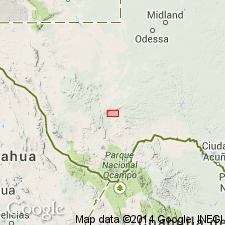
- Usage in publication:
-
- Poplar Tank Member*
- Modifications:
-
- Named
- Dominant lithology:
-
- Limestone
- Shale
- AAPG geologic province:
-
- Permian basin
Summary:
Named as the middle member of the Skinner Ranch Formation (new) for Poplar Tank, 1.5 mi south of the Lenox Hills, Glass Mountains, Brewster Co, TX in Permian basin. Overlies Decie Ranch Member (new) of Skinner Ranch. Underlies Sullivan Peak Member (new) of Skinner Ranch. Can be identified between the southern Lenox Hills east to east side of Hill 5021 where it tongues into the Skinner Ranch Formation undivided. The Decie Ranch and Sullivan Peak can be distinguished only where the Poplar Tank is present. The type section is in a ravine east-southeast of Hill 5300 in the central Lenox Hills, Altuda 15 min quad. Section 248 ft thick was measured at the type where the member consists of (ascending): dark platy to thin-bedded limestone and shale; gray hard shale; and gray massive limestone. Cross section. Abundant fossils; productid brachiopod is the most distinctive. Of Leonardian, Early Permian age.
Source: GNU records (USGS DDS-6; Denver GNULEX).
For more information, please contact Nancy Stamm, Geologic Names Committee Secretary.
Asterisk (*) indicates published by U.S. Geological Survey authors.
"No current usage" (†) implies that a name has been abandoned or has fallen into disuse. Former usage and, if known, replacement name given in parentheses ( ).
Slash (/) indicates name conflicts with nomenclatural guidelines (CSN, 1933; ACSN, 1961, 1970; NACSN, 1983, 2005, 2021). May be explained within brackets ([ ]).

